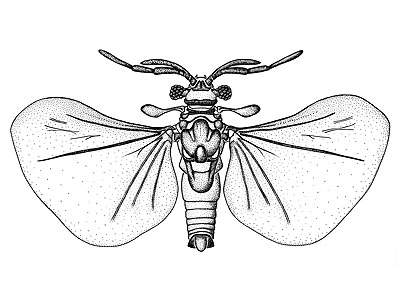
Order
STREPSIPTERA(Greek, strepsis = twisting; pteron = wing)
Common Names
stylops
Description
Strepsipterans are highly specialised parasites of other insects. They are probably closely related to Coleoptera (beetles) or Diptera (flies). The species within this order show an extreme form of sexual dimorphism: the adult male is a free-living winged insect, while the adult female is a "maggot-like" organism within the body of the host (endoparasite). Adult males have bulging compound eyes with a few facets - there are no simple eyes (ocelli). Mandibles are present but small. The forewings are reduced to stubs but the hind wings are broad with a few veins. Males live for only a few hours after leaving their hosts and probably do not feed - their only activity is to find females for reproduction. Males are quite small (less than 5 mm long) and are probably not rare but their small size and short life spans means that they are not often encountered. Females remain within the body of the host insect.
Life Cycle
Eggs hatch within the female strepsipteran and the juveniles travel out of the female's brood passage to the surface of the host. Juveniles leave while the host is visiting a flower. The larvae are six-legged and have compound eyes but lack antennae and mandibles. They attach themselves to an insect visiting the flower on which they have alighted. The parasite absorbs nutrients directly through its skin. Males pupate in the host and then emerge by pushing off a small cuticle cap which protrudes from the host's body. Females attract males by scent (pheromones).
Food
Strepsipterans feed on the body of other insects. Hosts include bees, wasps or other members of the Order Hymenoptera.
Importance
The importance of strepsipterans is unknown at present.